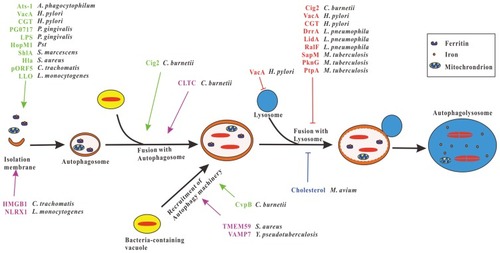Figures & data
Table 1 Effectors And Host Targets Involve In Bacterial Exploitation Of Autophagy
Figure 1 Exploitation of autophagy pathway by bacterial pathogens. After the invasion of the host cell, vacuoles containing intracellular bacteria fuse with autophagosomes or recruit autophagy machinery to form autophagic vacuoles favor the bacteria replication. Several bacteria have evolved different effector proteins that induce autophagy to form autophagosomes or promote bacteria-containing vacuoles fuse with autophagosomes or facilitate the recruitment of autophagy machinery to bacteria-containing vacuoles (green), thereby promoting the replication of bacteria. Some bacteria secrete effector proteins that impair the functions of lysosomes or inhibit bacteria-containing autophagosomes fuse with lysosomes (red) to block the lysosomal degradation of the bacteria. Furthermore, cholesterol of host cells prevents M. avium-containing autophagosomes fusion with lysosomes (blue), CLTC promotes C. burnetii-containing vacuoles fusion with autophagosomes, HMGB1 and NLRX1 induce mitophagy thus promote survival of C. trachomatis and L. monocytogenes respectively, TMEM59 and VAMP7 facilitate the recruitment of autophagy proteins to the S. aureus and Y. pseudotuberculosis-containing vacuoles, respectively (violet), and UPEC benefits from ferritinophagy.

